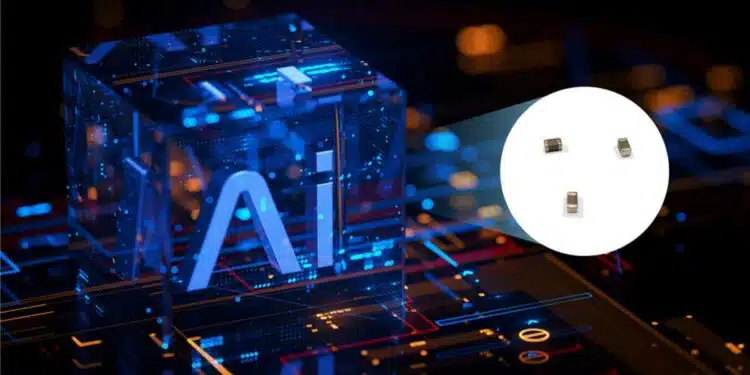Samsung Electro-Mechanics is proud to announce the launch of its latest ultra-high-capacitance MLCCs ceramic capacitors CL31X227MRKNNW# (1206 inch, 220 µF, 4Vdc, X6S) and CL32X337MSVN4S# (1210 inch, 330 µF, 2.5 Vdc, X6S), designed to meet the demanding requirements of AI servers and data centers.
These advanced components are essential for high-performance computing and high-speed communications, crucial for processing and analyzing vast amounts of data.
AI servers and data centers require high-performance computing and high-speed communications in order to process and analyze large volumes of data. Under these circumstances, numerous high-performance ICs (CPU, GPU, ASIC, etc.) are applied.
This leads to heat dissipation, which causes large current transients during intensive computation. Ultra-high-capacitance MLCCs are suitable as decoupling capacitors for high-frequency noises and responding to peak current demands.
The new MLCCs, including the CL31X227MRKNNW# (1206 inch, 220 µF, 4Vdc, X6S) and CL32X337MSVN4S# (1210 inch, 330 µF, 2.5 Vdc, X6S), are specifically engineered to decouple high-frequency noises and efficiently respond to peak current demands during intensive computation. This innovation is vital for managing heat dissipation and large current transients in AI server applications.
Application of High-Temperature / Ultra-High-Capacitance MLCCs, CPO Switch (Co-Packaged Optics Switch)
In addition to their application in AI servers, these ultra-high-capacitance MLCCs are also suitable for use in Co-Packaged Optics (CPO) Switches. CPO Switches, which integrate optical components and network switch chips into a single package, enable ultra-high-speed data transmission in data centers and high-performance computing environments.
The increased temperature and power consumption from optical engines necessitate the use of ultra-high-capacitance, high-temperature MLCCs of X7 or higher. Samsung Electro-Mechanics recommends the CL32X337MSVN4S#, CL31X227MRKNNW#, CL32Z227MSVN4S#, and CL31Z107MRKN4N# for these applications.
Application Proposal: Thickness-Constrained PCIe Card / OAM Socket, 220 µF Ultra-High-Capacitance MLCCs
A PCIe Card (Peripheral Component Interconnect Express Card) supports high-speed data transfer for the fast transmission of large-volumes of data. Graphics cards, storage devices, network adapters, AI accelerators and other components require high-power and high-speed data handling. To ensure power stability, multiple high-capacitance MLCCs are demanded.
When multiple PCIe cards are installed within an AI server (refer to Figure 2), space constraints and thermal considerations make thickness-limited ultra-high-capacitance MLCCs desirable. We propose ultra-high-capacitance MLCCs (thickness ≤ 2.0mm), such as CL31X227MRKNNW# and CL31A227MQKNNW#.
OAM Socket (Open-Compute-Project Accelerator Module Socket) is an interface designed for high-performance modules including GPUs for AI/ML workloads or custom ASICs. Using a custom ASIC in an Accelerator Module enables optimization of performance-per-watt and the removal of unnecessary circuitry to place memory closer. However, custom ASICs contain a large number of switching circuits that generate rapid transient currents. To handle such sudden current changes, high-capacitance MLCCs are required. They also serve to decouple, remove high-frequency noise and stabilize voltage.
As shown in Figure 3, numerous ultra-high-capacitance MLCCs can be mounted on the OAM PCB Land Side — e.g., CL31X227MRKNNW# (1206 inch / 1.9 t, 220 µF, 4 Vdc, X6S) and CL31A227MQKNNW# (1206 inch / 1.9 t, 220 µF, 6.3 Vdc, X5R) — contributing to improved space efficiency.
Samsung Electro-Mechanics continues to lead the industry in providing cutting-edge solutions that enhance the performance and reliability of AI servers and data centers. For more information, please contact:


































